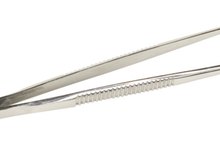How to Make a Tick Back Out
If you've ever taken a walk in the woods, chances are good that you've encountered a tick on your journey. It's important that you examine your entire body for ticks after being in potential tick-infected areas, such as forests, high grasses or anywhere deer might graze. Tick sizes vary, so look for anything unusual. A deer tick, for example, looks like a tiny black speck. If you do notice a tick on your body, it's imperative that you remove the tick as soon as possible 3.
If you are experiencing serious medical symptoms, seek emergency treatment immediately.
Liquid Soap Method
Squirt a large drop of liquid soap on a cotton ball.
How to Get an Embedded Tick Out
Learn More
Gently swab the tick with the cotton ball for 15 to 20 seconds. In most cases, the tick will back out on its own and stick to the cotton ball.
Cover your hands with rubber gloves and remove the tick manually if it did not back out on its own. This works best if you have fingernails to grasp the tick. Gently pinch the tick close to the skin and pull it out firmly without twisting. Do not squeeze the body of the tick too hard, because doing so can release toxins into your body.
Red Blemishes on the Back & Arms After Yard Work
Learn More
Place the extracted tick in a small glass jar or zipper-locking plastic bag and place in your freezer. Save the tick for 30 days, in case you develop signs of infection and the tick needs to be examined.
- Squirt a large drop of liquid soap on a cotton ball.
- This works best if you have fingernails to grasp the tick.
Tweezers Method
Grasp the tick with tweezers as close to the skin as possible. You want to grasp the tick on the mouth, but the size of the tick can make this hard to determine, so get as close to the injection site as you can.
Pull back slowly and firmly being sure not to twist, jerk back or squeeze the tick's body. Expect to take your time because the tick's mouth is covered with sharp barbs that stick in the skin.
Save the tick as described above or flush down the toilet. Never dispose of a tick in your trash because it could climb out and bite you again.
Tips
Examine yourself and your pets for ticks after each walk in the woods or camping. Seek medical attention if you cannot remove a tick on your own.
Warnings
Never attempt to remove a tick with your bare hands, as this can spread pathogens. Never apply substances like petroleum jelly or gasoline to a tick on your skin. Never attempt to remove a tick using a lighted match. Always seek medical attention promptly if you see signs of infection or Lyme disease.
- Grasp the tick with tweezers as close to the skin as possible.
- You want to grasp the tick on the mouth, but the size of the tick can make this hard to determine, so get as close to the injection site as you can.
Related Articles
References
- U.S. Army Center Tick Removal Guide
- American Family Physician: Tick Removal
- WebMD: How to Remove a Tick
- Centers for Disease Control and Prevention (CDC). Lyme Disease. CDC.gov.
- Centers for Disease Control and Prevention (CDC) staff. Tick Borne Diseases of the United States. CDC.gov.
- Centers for Disease Control and Prevention (CDC) staff. Overview of Tickborne Diseases. CDC.gov.
- Johns Hopkins Medicine, Rheumatology staff. What to do After a Tick Bite. Johns Hopkinsrheumatology.org.
- Mayo Clinic staff. Patient Care and Health Info. Tick Bites: First Aid. Mayo Clinic.org.
- Ostfeld, R. (2018) 8 Facts About the Ecology of Lyme. The Cary Institute of Ecosystem Studies. Caryinstitute.org.
- Zecken de Das Infoportal. About Ticks. Zecken.de.
Tips
- Examine yourself and your pets for ticks after each walk in the woods or camping.
- Seek medical attention if you cannot remove a tick on your own.
Warnings
- Never attempt to remove a tick with your bare hands, as this can spread pathogens.
- Never apply substances like petroleum jelly or gasoline to a tick on your skin.
- Never attempt to remove a tick using a lighted match.
- Always seek medical attention promptly if you see signs of infection or Lyme disease.
Writer Bio
Based in Rhode Island, Moira Richardson has been working as a freelance writer full-time for two years. She has been published in print for Providence Monthly, Campus Connection, The Newport Mercury, Prime Time Magazine, and SO Rhode Island. She has a bachelor's Degree in English: Creative Writing and is almost finished her master's degree in same field.







